NDVI stands for "Normalized Difference Vegetation Index". NRG stands for "Near-infrared / Red / Green". NDVI and NRG are both ways to visualize the amounts of infrared and other wavelengths of light reflected from vegetation. Because both these methods compare ratios of blue and red light absorbed versus green and IR light reflected, they can be used to evaluate the health of vegetation. It's a snapshot of how much photosynthesis is happening. This is helpful in assessing vegetative health or stress. (Read more here: https://www.agronomy.org/publications/jeq/articles/36/3/832) ## Do-It-Yourself These techniques for vegetation analysis were developed for satellite imagery, but at Public Lab, we've been working a lot on capturing infrared imagery using our DIY [near-infrared camera](/wiki/near-infrared-camera) setup, and combining it with visible bands to produce NDVI images such as the one above. ## What these images mean What exactly are these images we're trying to make? What do they tell us about vegetation, and why? These diagrams should help to understand what it is we're doing and why these are good ways to analyze plant life. ## The NDVI equation [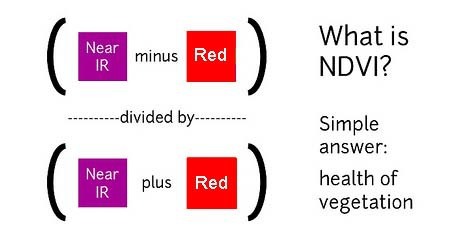](/i/44723) **NDVI = (Near Infrared - Red)/(Near Infrared + Red)** NDVI is a ratio which tries to emphasize photosynthesis while filtering out sun glare. The above equation is run for every pixel, using source data from an infrared photo and a visible light photo, like this pair: [](https://publiclab.org/system/images/photos/000/021/771/original/5390895115_c9d4d38fec_o.jpg) The result can be false-colored to make the high-photosynthesis areas more clear, and used to examine where plants are and how healthy they are. [](https://publiclab.org/system/images/photos/000/021/770/original/PetVISNDVIcomp.png) _Figure above: Normal color photo (right) and normalized difference vegetation index (NDVI) image (left). NDVI image was derived from two color channels in a single photo taken with a camera modified with a special infrared filter. Note that tree trunks, brown grass, and rocks have very low NDVI values because they are not photosynthetic. Healthy plants typically have NDVI values between 0.1 and 0.9. -- @cfastie_ ### Activities Here are a range of activities you can do to produce and interpret your own NDVI imagery, whether downloaded from a satellite imagery provider or [collected yourself using a DIY technique](/wiki/multispectral-imaging) [activities:ndvi] ****   Most DIY converted cameras today (those from Public Lab) use RGN instead of NRG, so the blue channel represents infrared instead of the red channel. That looks like this: [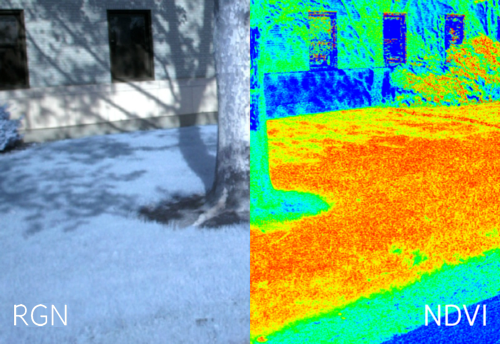](/i/45468?s=o) **** ## NRG imagery Some people are also interested in producing NRG imagery (like the below image), where `Near-Infrared, Red, and Green` are used to compose a picture instead of the usual `Red, Green, and Blue`. [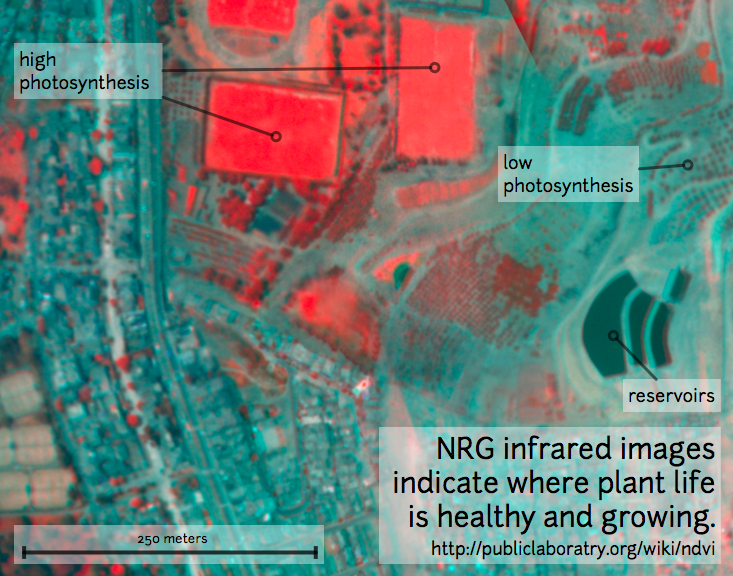](/i/25064) This diagram explains the swapping, which allows us to 'see' infrared as if it were a normal color: [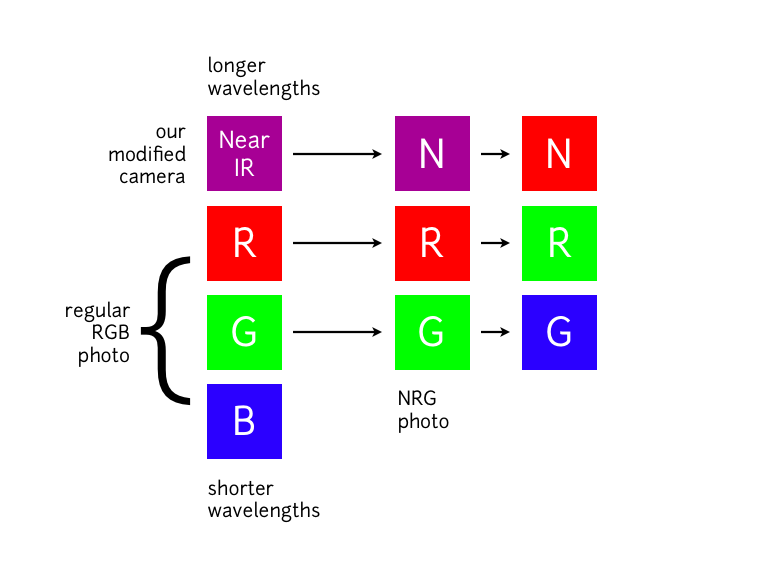](/i/25063) **In NRG images, the deeper and clearer the red color, the denser and healthier the vegetation (more or less).** ### Questions [questions:ndvi] ### Other examples of DIY NDVI imaging From around the internet: Begin watching at 2 minutes to see the resulting imagery: *This topic is part of the [Grassroots Mapping Curriculum](/wiki/mapping-curriculum) series.* **** [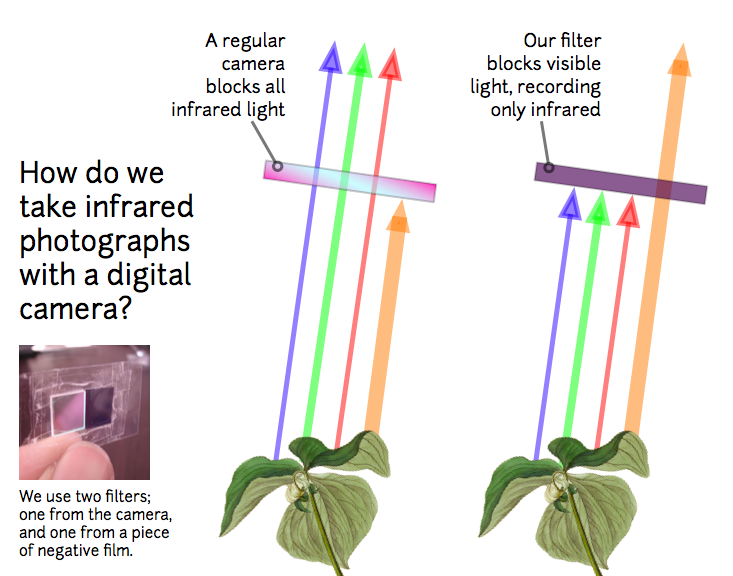](/i/25066) [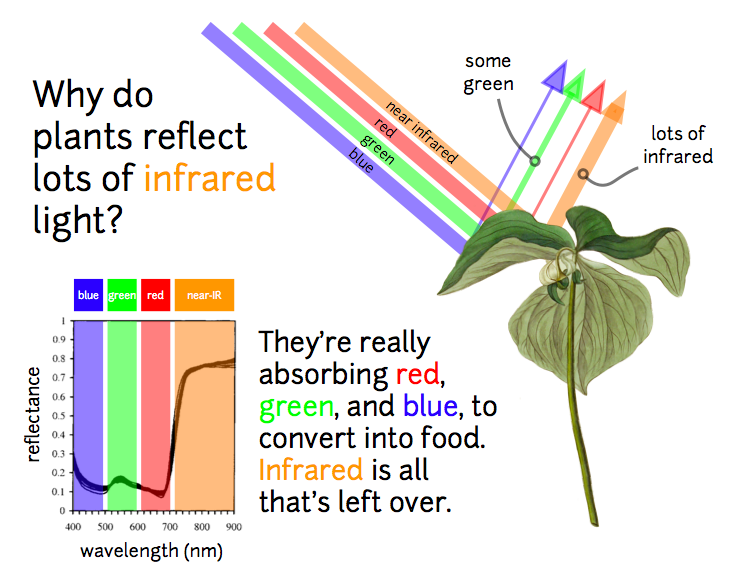](/i/25065) ...
| Author | Comment | Last activity | Moderation | ||
|---|---|---|---|---|---|
| FrankA | "Hi Suman. This is my setup… Mobius Action cam Docking station + Foam anti vibration tubing… all held on with quick release cable ties. I have the..." | Read more » | almost 8 years ago | |||
| suman | "Dear FrankA, Greetings from Nepal, I have a mobius actioncam ( Green Blue and Near Infrared ) which is modified to take near infrared spectrum for..." | Read more » | almost 8 years ago | |||
| sujayj | "Thanks Chris " | Read more » | almost 8 years ago | |||
| cfastie | "You can use any filter that blocks most blue and green light (all visible light other than red) and also passes a lot of near infrared light (somew..." | Read more » | almost 8 years ago | |||
| cfastie | "Finding inexpensive, do-it-yourself calibration targets is an obstacle to NDVI calibration. You need targets for which the spectral reflectance is ..." | Read more » | almost 8 years ago | |||
| cfastie | "Photoshop. Also easy with Fiji. Probably also possible with many photo editing programs. " | Read more » | almost 8 years ago | |||
| aldrin | "Sir @chris,what software did you use to select a part of the image and check its histogram? " | Read more » | almost 8 years ago | |||
| J_tanna | "@cfastie sample image is like this, " | Read more » | almost 8 years ago | |||
| J_tanna | "@cfastie On an agriculture land, How can we specify the targets for calibration? " | Read more » | almost 8 years ago | |||
| dbehr | "Thx. @cfastie " | Read more » | almost 8 years ago | |||
| cfastie | "Trying slightly different values could yield better results in some situations. CLF_SYSCFG.TXT " | Read more » | almost 8 years ago | |||
| dbehr | "Hi, I have Mobius Infragarm cam for NDVI. I can't locate the White Balance settings for the mSetup program. Can you pls. give the values or a link..." | Read more » | almost 8 years ago | |||
| cfastie | "Here is my discussion of calibrating NDVI images: https://publiclab.org/notes/cfastie/05-01-2016/calibration-cogitation And Ned's most recent note..." | Read more » | almost 8 years ago | |||
| J_tanna | "@cfastie Thank you for your time. I have two more doubts in my mind, 1.) What are the steps that I need to apply for image calibration? 2.) What is..." | Read more » | almost 8 years ago | |||
| cfastie | "With a blue filter which blocks only red light, the red channel will capture NIR. Use the red channel for NIR and the blue channel for visible ligh..." | Read more » | almost 8 years ago | |||
| cfastie | "With a blue filter which blocks only red light, the red channel will capture NIR. Use the red channel for NIR and the blue channel for visible ligh..." | Read more » | almost 8 years ago | |||
| J_tanna | "@cfastie What should be the formula of NDVI for NIR camera as it is blocking red light. " | Read more » | almost 8 years ago | |||
| platteferguson | "So my million dollar question do I buy 3 or 4 inspire 2.0 with extra batteries or go for the new Ebee SQ ag drone for 12-15k with the multi spec wi..." | Read more » | almost 8 years ago | |||
| rs806 | "Okay thanks Ned! I had been wondering about the structure of the csv file since, judging from the script, it had quite a few columns of information..." | Read more » | almost 8 years ago | |||
| nedhorning | "The CSV file for the R script is different form the table in the "Improved DIY NIR camera calibration" post. The CSV file has the reflectance value..." | Read more » | almost 8 years ago | |||
| rs806 | "@nedhorning Hello Ned thank you for posting the R script. I'm finding it helpful to understand the process by going through the script itself. I wa..." | Read more » | almost 8 years ago | |||
| warren | "Hi, just wondering about my question on the screw in the photo below -- is that to unscrew the lens assembly itself? " | Read more » | almost 8 years ago | |||
| dannysmith | "thanks @Claytonb, they seem like the way to go " | Read more » | almost 8 years ago | |||
| Claytonb | "@dannysmith -I have been using the Labsphere Permaflect coated targets http://labsphere.com/labsphere-products-solutions/materials-coatings-2/coati..." | Read more » | almost 8 years ago |